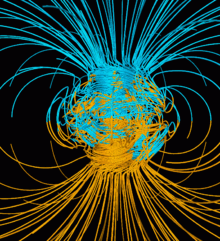Tandem Reconnection and Cusp Electrodynamics Reconnaissance Satellites: Difference between revisions
No edit summary Tags: Mobile edit Mobile web edit Advanced mobile edit |
Hatifnatter (talk | contribs) No edit summary |
||
| Line 46: | Line 46: | ||
}} |
}} |
||
'''Tandem Reconnection and Cusp Electrodynamics Reconnaissance Satellites''' ('''TRACERS''') is a planned orbiter mission tasked to study the origins of the [[solar wind]] and how it affects [[Earth]]. The [[Principal Investigator]] is Craig Kletzing at the [[University of Iowa]] in [[Iowa City, Iowa]]. Not including rideshare costs, TRACERS is funded US$115 million.The two microsatellites are to be flown as secondary satellites on a mission carring the four[[Polarimeter to Unify the Corona and Heliosphere]] (PUNCH) satellites. |
'''Tandem Reconnection and Cusp Electrodynamics Reconnaissance Satellites''' ('''TRACERS''') is a planned orbiter mission tasked to study the origins of the [[solar wind]] and how it affects [[Earth]]. The [[Principal Investigator]] is Craig Kletzing at the [[University of Iowa]] in [[Iowa City, Iowa]]. Not including rideshare costs, TRACERS is funded US$115 million.The two microsatellites are to be flown as secondary satellites on a mission carring the four [[Polarimeter to Unify the Corona and Heliosphere]] (PUNCH) satellites. |
||
== Overview == |
== Overview == |
||
Revision as of 12:11, 30 December 2021
| Names | TRACERS |
|---|---|
| Mission type | Heliophysics |
| Operator | NASA |
| Spacecraft properties | |
| Spacecraft | TRACERS |
| Spacecraft type | Orbiters (2) |
| Manufacturer | Millennium Space Systems[1] |
| Start of mission | |
| Launch date | October 2023 (planned)[2][3] |
| Orbital parameters | |
| Reference system | Geocentric orbit |
| Regime | Low Earth orbit Polar [4] |
| Altitude | 600 km |
Small Explorer program (SMEX) | |
Tandem Reconnection and Cusp Electrodynamics Reconnaissance Satellites (TRACERS) is a planned orbiter mission tasked to study the origins of the solar wind and how it affects Earth. The Principal Investigator is Craig Kletzing at the University of Iowa in Iowa City, Iowa. Not including rideshare costs, TRACERS is funded US$115 million.The two microsatellites are to be flown as secondary satellites on a mission carring the four Polarimeter to Unify the Corona and Heliosphere (PUNCH) satellites.
Overview

TRACERS is a pair of identical spacecraft that will be launched as a secondary mission to another orbiter named Polarimeter to Unify the Corona and Heliosphere (PUNCH) and will operate in synergy; PUNCH will study the solar wind, a stream of charged particles emanating from the Sun, while TRACERS will study Earth's response.[5]
TRACERS will observe solar particles interacting with Earth's magnetic field at the northern magnetic cusp region. Here, the field lines guide particles from the boundary between Earth's magnetic field down into the atmosphere. In a process known as magnetic reconnection, the field lines violently reconfigure, sending particles out at speeds that can approach the speed of light. Some of these particles will be guided by the Earth's field into the region where TRACERS can observe them.[5][1] TRACERS will study a longstanding question about where reconnection happens at the magnetopause and how the solar wind affects the place and timing, helping NASA better forecast the influx of energetic particles into Earth's magnetic field that has the potential to disrupt the power grid and satellite communications.[5][4] TRACERS and PUNCH will work well together with the other existing heliophysics spacecraft.[1]
On 20 June 2019, NASA announced that PUNCH and TRACERS were the winning candidates to become the next missions in the agency's Small Explorer program, to be launched together in October 2023.[2][3] The twin TRACERS spacecraft will carry instruments built by the University of California Berkeley, Space Sciences Laboratory (SSL).[4]
Instruments
The instrumentation suite of five primary instruments was chosen specifically to meet science objectives.[6]
- DC Magnetometer (MAG) a fluxgate magnetometer that provides measurements of the background magnetic field up to 5 Hz.
- A Search coil magnetometer (MSC) three-axis magnetic search coil to measure AC magnetic field from 2 Hz up to 1 kHz.
- An Electric Field Instrument (EFI) a two axis electric field experiment to measure electric fields from 1 Hz to 1 kHz.
- Analyzer for Cusp Electrons (ACE) an electrostatic analyzer to measure cusp electrons from 40 eV to 10 keV.
- Analyzer for Cusp Ions (ACI) is an electrostatic analyzer to measure cusp ions from 50 eV to 10 keV.
A technology demonstration, Magnetometers for Innovation and Capability (MAGIC), was added in 2020 with the goal to test prototype magnetic-field instruments.[7]
See also
References
- ^ a b c NASA selects missions to observe the sun and its impact on Earth, Stephen Clark, Spaceflight Now, 26 June 2019
- ^ a b Frazier, Sarah (27 July 2021). "NASA's PUNCH Mission to Study the Sun's Environment Moves Toward Launch". NASA. Retrieved 28 July 2021.
- ^ a b "SwRI-managed TRACERS heliophysics mission enters Phase B". SwRI (Press release). 22 June 2020. Retrieved 3 May 2021.
- ^ a b c Berkeley satellites could be exploring Mars and Earth by 2022. By Robert Sanders, Berkeley News, 9 July 2019.
- ^ a b c NASA Selects Missions to Study Our Sun, Its Effects on Space Weather, NASA Press Release, 20 June 2019
- ^ TRACERS instrumentation, University of Iowa Physics and Astronomy, June 2019
- ^ Allen, Molly (24 June 2020). "UI-led space mission funded by $115 million grant from NASA takes next step". The Daily Iowan. Retrieved 3 May 2021.

